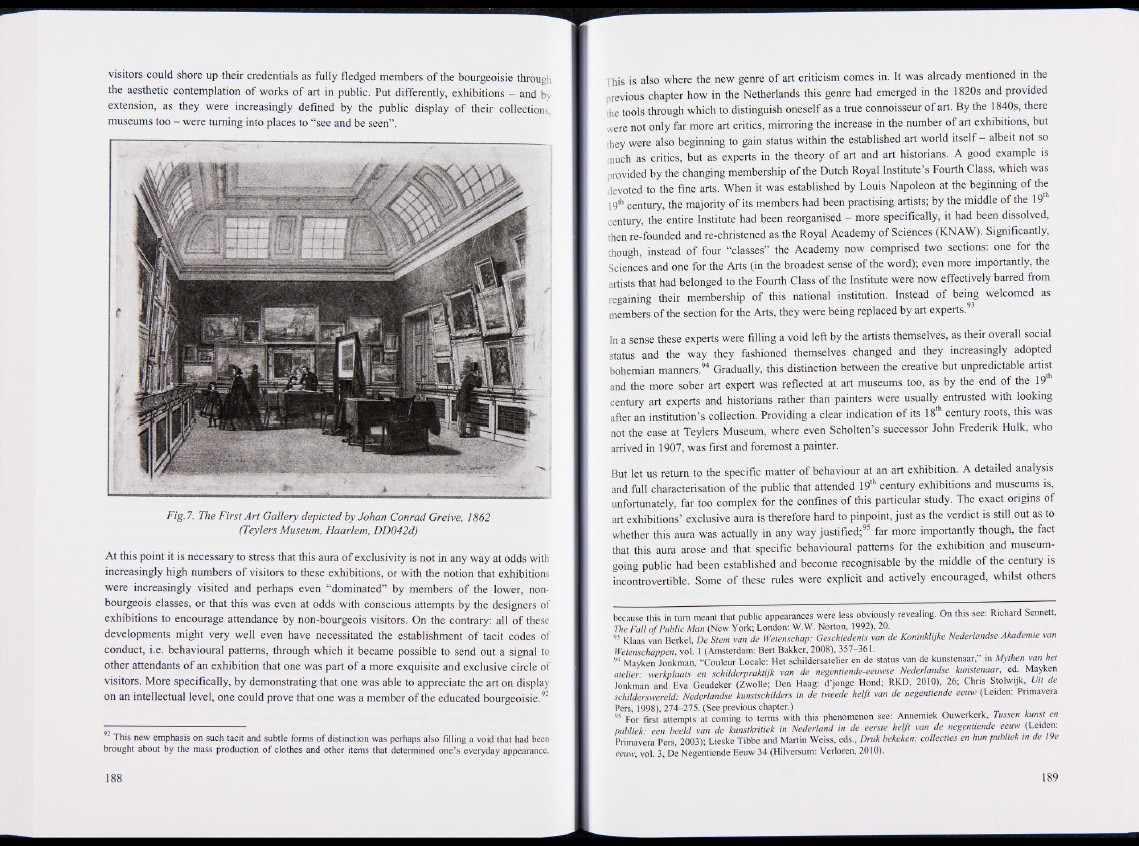
visitors could shore up their credentials as fully fledged members of the bourgeoisie through
the aesthetic contemplation of works of art in public. Put differently, exhibitions - and by
extension, as they were increasingly defined by the public display of their collections,
museums too - were turning into places to “see and be seen”.
Fig.7. The First Art Gallery depicted by Johan Conrad Greive, 1862
(Teylers Museum, Haarlem, DD042d)
At this point it is necessary to stress that this aura of exclusivity is not in any way at odds with
increasingly high numbers of visitors to these exhibitions, or with the notion that exhibitions
were increasingly visited and perhaps even “dominated” by members of the lower, nonbourgeois
classes, or that this was even at odds with conscious attempts by the designers of
exhibitions to encourage attendance by non-bourgeois visitors. On the contrary: all of these
developments might very well even have necessitated the establishment of tacit codes of
conduct, i.e. behavioural patterns, through which it became possible to send out a signal to
other attendants of an exhibition that one was part of a more exquisite and exclusive circle of
visitors. More specifically, by demonstrating that one was able to appreciate the art on display
on an intellectual level, one could prove that one was a member of the educated bourgeoisie.92
This new emphasis on such tacit and subtle forms o f distinction was perhaps also filling a void that had been
brought about by the mass production o f clothes and other items that determined one’s everyday appearance,
This is also where the new genre of art criticism comes in. It was already mentioned in the
previous chapter how in the Netherlands this genre had emerged in the 1820s and provided
the tools through which to distinguish oneself as a true connoisseur of art. By the 1840s, there
were not only far more art critics, mirroring the increase in the number of art exhibitions, but
they were also beginning to gain status within the established art world itself gfalbeit not so
much as critics, but as experts in the theory of art and art historians. A good example is
provided by the changing membership of the Dutch Royal Institute’s Fourth Class, which was
devoted to the fine arts. When it was established by Louis Napoleon at the beginning of the
19th century, the majority of its members had been practising artists; by the middle of the 19
century, the entire Institute had been reorganised# more specifically, it had been dissolved,
then re-founded and re-christened as the Royal Academy of Sciences (KNAW). Significantly,
though, instead of four “classes” the Academy now comprised two sections: one for the
Sciences and one for the Arts (in the broadest sense of the word); even more importantly, the
artists that had belonged to the Fourth Class of the Institute were now effectively barred from
regaining their membership of this national institution. Instead of being welcomed as
members of the section for the Arts, they were being replaced by art experts.
In a sense these experts were filling a void left by the artists themselves, as their overall social
status and the way they fashioned themselves changed and they increasingly adopted
bohemian manners.94 Gradually, this distinction between the creative but unpredictable artist
and the more sober art expert was reflected at art museums too, as by the end of the 19
century art experts and historians rather than painters were usually entrusted with looking
after an institution’s collection. Providing a clear indication of its 18th century roots, this was
not the case at Teylers Museum, where even Scholten’s successor John Frederik Hulk, who
arrived in 1907, was first and foremost a painter.
But let us return to the specific matter of behaviour at an art exhibition. A detailed analysis
and full characterisation of the public that attended 19th century exhibitions and museums is,
unfortunately, far too complex for the confines of this particular study. The exact origins of
art exhibitions’ exclusive aura is therefore hard to pinpoint, just as the verdict is still out as to
whether this aura was actually in any way justified;95 far more importantly though, the fact
that this aura arose and that specific behavioural patterns for the exhibition and museum-
going public had been established and become recognisable by the middle of the century is
incontrovertible. Some of these rules were explicit and actively encouraged, whilst others
because this in turn meant that public appearances were less obviously revealing. On this see: Richard Sennett,
The Fall o f Public Man (New York; London: W.W. Norton, 1992), 20.
93 Klaas van Berkel, De Stem van de Wetenschap: Geschiedenis van de Koninklijke Nederlandse Akademie van
Wetenschappen, vol. 1 (Amsterdam: Bert Bakker, 2008), 35|l i 361.
94 Mayken Jonkman, “Couleur Locale: Het schildersatelier en de status van de kunstenaar,” in Mythen van het
atelier: werkplaats en schilderpraktijk van de negentiende-eeuwse Nederlandse kunstenaar, ed. Mayken
Jonkman and Eva Geudeker (Zwolle; Den Haag: d’jonge Hond; RKD, 2010), 26; Chris Stolwijk, Ult de
schilderswereld: Nederlandse kunstschilders in de tweede helft van de negentiende eeuw (Leiden: Pnmavera
Pers, 1998), 274-275. (See previous chapter.) , , „
95 For first attempts at coming to terms with this phenomenon see: Annemiek Ouwerkerk, Tussen kunst en
publiek■ een beeid van de kunstkritiek in Nederland in de eerste helft van de negentiende eeuw (Leiden:
Primavera Pers, 2003); Lieske Tibbe and Martin Weiss, eds., Druk bekeken: collecties en hun publiek in de 19e
eeuw, vol. 3, De Negentiende Eeuw 34 (Hilversum: Verloren, 2010).